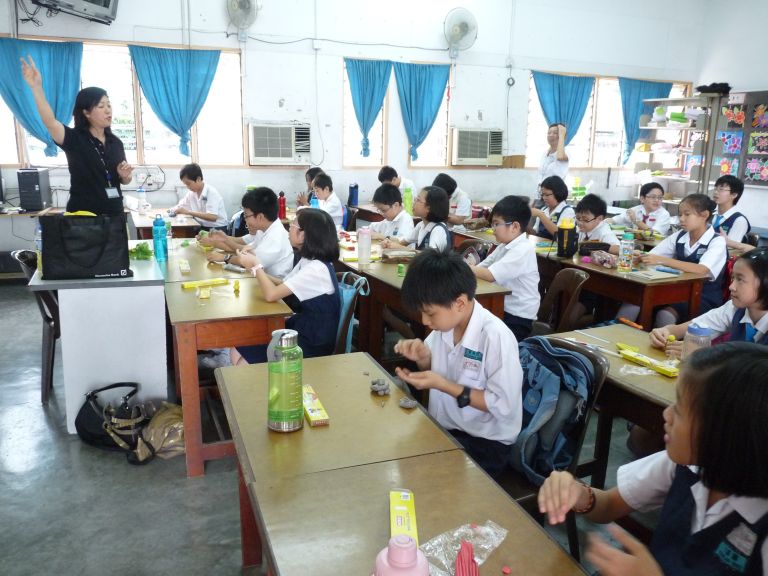- Study in AustraliaAustralian Universities/CollegesPrograms by faculty AusAustralian VisasLife in Australia
- Study In New ZealandNew Zealand UniversitiesPrograms by Faculty NZNew Zealand VisasLife in New Zealand
- Study in CanadaUniversities/Colleges in CANADAPrograms by faculty CanadaCanadian VisasLife in Canada
Primary education
Primary education
Primary education in Malaysia begins at age seven and lasts for six years, referred to as Year (Tahun) 1 to 6 (also known as Standard (Darjah) 1 to 6). Year 1 to Year 3 are classified as Level One (Tahap Satu) while Year 4 to Year 6 are considered as Level Two (Tahap Dua). Students are promoted to the next year regardless of their academic performance.
From 1996 until 2000, the Penilaian Tahap Satu (PTS) or the Level One Evaluation was administered to Year 3 students. Excellence in this test allowed students to skip Year 4 and attend Year 5 instead. However, the test was removed from 2001 onwards due to concerns that parents and teachers were unduly pressuring students to pass the exam.
Before progressing to secondary education, Year 6 pupils sit for the Primary School Achievement Test (Ujian Pencapaian Sekolah Rendah, UPSR). The subjects tested are Malay comprehension, written Malay, English, Science and Mathematics. In addition to the five subjects, Chinese comprehension and written Chinese are compulsory in Chinese schools, while Tamil comprehension and written Tamil are compulsory in Tamil schools.

School types and medium of instruction
Public primary schools are divided into two categories based on the medium of instruction:
- Malay-medium National Schools (Sekolah Kebangsaan, SK)
- non-Malay-medium National-type Schools (Sekolah Jenis Kebangsaan, SJK), also known as "vernacular schools", further divided into
- National-type School (Chinese) (Sekolah Jenis Kebangsaan (Cina), SJK(C)), Mandarin-medium and simplified Chinese writing
- National-type School (Tamil) (Sekolah Jenis Kebangsaan (Tamil), SJK (T)), Tamil-medium
All schools admit students regardless of racial and language background.
Malay and English are compulsory subjects in all schools. All schools use the same syllabus for non-language subjects regardless of the medium of instruction. The teaching of the Chinese language is compulsory in SJK(C), and Tamil language is compulsory in SJK(T). Additionally, a National School must provide the teaching of Chinese or Tamil language, as well as indigenous languages wherever practical, if the parents of at least 15 pupils in the school request that the particular language to be taught.
In January 2003, a mixed medium of instruction was introduced so that students would learn Science and Mathematics in English. Due to pressure from the Chinese community, SJK(C) teach Science and Mathematics in both English and Chinese. However, the government reversed the policy of teaching Science and Mathematics in English in July 2009, and previous languages of instruction will be reintroduced in stages from 2012.
By degree of government funding, National Schools are government-owned and operated, while National-type Schools are mostly government-aided, though some are government-owned. In government-aided National-type Schools, the government is responsible for funding the school operations, teachers’ training and salary, and setting the school curriculum, while the school buildings and assets belong to the local ethnic communities, which elect a board of directors for each school to safeguard the school properties. Between 1995 and 2000, the Seventh Malaysia Plan allocation for primary education development allocated 96.5% to National Schools which had 75% of total enrollment. Chinese National-type Schools (21% enrollment) received 2.4% of the allocation while Tamil National-type Schools (3.6% enrollment) received 1% of the allocation.
Previously, there were also other types of National-type Schools. The English National-type Schools were assimilated to become National Schools as a result of decolonization. Others, such as those for the Punjabi language were closed due to the dwindling number of students. The role of promoting the Punjabi language and culture is currently fulfilled by Gurdwaras (Sikh temples) based organizations.
The division of public education at the primary level into National and National-type Schools has been criticised for allegedly creating racial polarisation at an early age. To address the problem, attempts have been made to establish Sekolah Wawasan ("vision schools"). Under the concept, three schools (typically one SK, one SJK(C) and one SJK(T)) would share the same school compound and facilities while maintaining different school administrations, ostensibly to encourage closer interaction. However, this was met with objections from most of the Chinese and Indian communities as they believe this will restrict the use of their mother tongue in schools.
For more information, please contact one of our offices
Study in Australia | Study in the UK | Study in Malaysia | Study in Canada | Study in the USA | Study in New Zealand
Editor: Nina Zarabi













